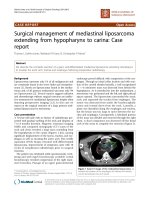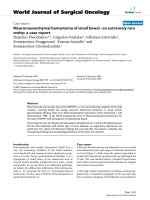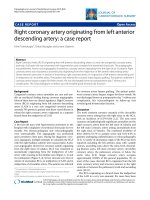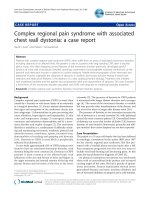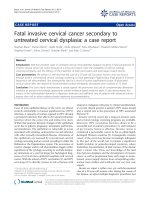Báo cáo y học: "Natural evolution of desmoplastic fibroblastoma on magnetic resonance imaging: a case report" ppt
Bạn đang xem bản rút gọn của tài liệu. Xem và tải ngay bản đầy đủ của tài liệu tại đây (1.32 MB, 4 trang )
CAS E REP O R T Open Access
Natural evolution of desmoplastic fibroblastoma
on magnetic resonance imaging: a case report
Yusaku Kamata
1
, Ukei Anazawa
1*
, Hideo Morioka
1
, Takeshi Morii
2
, Keiko Miura
1
, Makio Mukai
3
, Hiroo Yabe
1
and
Yoshiaki Toyama
1
Abstract
Introduction: Desmoplastic fibroblastoma (collagenous fibroma) is a recently described tumor thought to arise
predominantly from subcutaneous tissue or skeletal muscle. The natural evolution of this tumor on magnetic
resonance imaging has never been described, to the best of our knowledge. We herein report a case of
desmoplastic fibroblastoma arising in the thigh and show the longitudin al magnetic resonance imaging findings.
Case presentation: A 60-year-old Japanese man presented with swelling of the medial side of his right thigh, and
he complained of nighttime pain and slight tenderness. Magnetic resonance imaging demonstrated a 4 × 4 cm mass
in the right thigh. Open biopsy was performed. The mass was diagnosed histologically as a benign fibrous tumor,
and we maintained follow-up without surgical therapy. After one year, magnetic resonance imaging showed an
increase in tumor size to 4 × 5 cm, but the histologic findings were the same as those obtained one year earlier.
Resection was performed with narrow surgical margins. Pathologic diagnosis was desmoplastic fibroblastoma. Two
years after surgery, the patient is free from pain and shows no signs or symptoms of recurrence.
Conclusion: The natural evolution of desmoplastic fibroblastoma is characterized by no changes in patterns on
magnetic resonance imaging despite increasing size. This finding is clinically helpful for distinguishing desmo plastic
fibroblastoma with increasing pain from the desmoid tumor.
Introduction
In 1995, Evans [1] first described desmoplastic fibroblas-
toma, a unique fibrous soft tissue tumor comprising
spindle-shaped to stellate fibroblastic cells sparsely dis-
tributed in a dense fibrous background. This tumor,
alternatively called collagenous fibroma [2], was clinically
and morphologically distinct, as w ell as completely
benign in previously reported series. Details of magnetic
resonance imaging (MRI) findings for this tumor have
been described for three cases [3,4], but the natural evo-
lution of this tumor has never been described. Here, we
present the natural evolution of this tumor on MRI.
Case presentation
A 60- year-old Japanese man presented with swelling of
the medial side of his right thigh and c omplained of
night pain and slight tenderness. Palpation disclosed a
hard, well-circumscrib ed, mobile tumor. Otherwise
healthy, he had no history of trauma to the thigh. The
results of routine laboratory studies were normal.
MRI demonstrated a 4 × 4 cm mass in the right thigh,
occupying a space between the vastus medialis, sartorius
and semimembranosus muscles (Figure 1A , B). Ope n
biopsy was performed. Because the mass was diagnosed
histologically as a benign fibrous tumor, we maintained
follow-up without surgical therapy. After one year, MRI
showed an increase in tumor size to 4 × 5 cm. T1-
weighted images characterized the mass as well-circum-
scribed and inhomogeneous, with signals predominantly
isointense with muscle, but including several areas of
low signal i ntensity (SI) (Figure 2A). On T2-weighted
images, the mass predominantly showed low SI with
scattered high-SI areas (Figure 2B). These MRI findings
were the same as those obtained one year previously
except for tumor size. T1-weighted images after contrast
agent administration revealed heterogeneous enhance-
ment of the lesion. Nonenhanced areas correspond ed to
regions with low SI on no ncontr ast T1-weighted images
* Correspondence:
1
Department of Orthopaedic Surgery, Keio University, 35 Shinanomachi,
Shinjuku-ku, Tokyo 160-8582, Japan
Full list of author information is available at the end of the article
Kamata et al. Journal of Medical Case Reports 2011, 5:139
/>JOURNAL OF MEDICAL
CASE REPORTS
© 2011 Kamata et al; li censee BioMed Central Ltd. This is an Open Access article distributed under the terms of the Creative Commons
Attribution License ( which permits unrestricted use, distribution, and reproduction in
any medium, provided the or iginal work is properly cited.
(Figure 2C). Based on this growth, with pain and
enhancement of the lesion, resection was performed
with narrow surgical margins; the tumor adjoined the
vastus medialis, sartorius and semimembranosus mus-
cles and was adjacent to Hunter’ s canal with fibrous
adhesion to the adductor magnus tendon.
Pathologically, the tumor showed well-circumscribed
borders and low vascularity (Figure 3A). Spindle- shaped
and stellate fibroblastic cells wer e sparsely distributed in
a dense fibrous background. In some myxocollagenous
areas, cellularity was greater than in the fibrous area
(Figure 3A, B). No mitotic figures were seen. The patho-
logic diagnosis was desmoplastic fibroblastoma.
At the most recent follow-up examination two years
after surgery, the patient was free from pain and showed
no signs or symptoms of recurrence.
Discussion
Evans [1] used the designation desmoplastic fibroblas-
toma when he described seven patients having masses
with distinct morphologic characteristics. Subsequently,
Nielsen et al. [2] report ed seven other cases and pro-
posed t hat the tumor be renamed collagenous fibroma,
arguing that desmoplastic fibroblastoma misleads the
reader into believing that the lesion consists of imma-
ture tumor cells inducing a desmoplastic response in
host tissues.
These neoplasms typically occur in the fifth or sixth
decades of life and occur two and a half times more often
in men than women. Clinically, desmoplastic fibroblas-
toma presents as a firm, mobile, slowly growing mass
located in subcutaneous tissue or near the deep aspect of
skeletal muscles. Common locations include the arm,
shoulder, posterior neck and upper back [1-8]. Few pre-
vious reports have described tumors arising in the thigh
[1,2,6,8]. In the present patient, the tumor appeared to
arise from the fascia of the thigh muscles. Such tumors
located in the intermuscular space have not been
described. The mass is usually painless; however, our
patient complained of pain, as have those in some pre-
vious reports [3,5,6]. In our case, location of the tumor
adjacent to Hunter’s canal may have contributed to pain
by compressing the saphenous nerve in the canal.
Previous authors recommended treatment of desmo-
plastic fibro blastoma by to tal surgical excision. No
tumor recurrence during follow-up has been reported,
including the present case.
On MRI, T1-weighted images of the mass depicted a
mixture of low SI and isointensity. With T2-weighting,
the mass showed scattered high-SI areas within a zone
of low SI. Contrast T1-weighted images dem onstrated
inhomogeneous enhancement after contrast administra-
tion, and nonenhanced areas corresponding to regions
showing low SI on noncontrast T1-weighted images.
Thesizeofthetumorincreasedoverthecourseofone
year, but the MRI findings of the tumor showed no
changes.
Figure 1 Magnetic resonance imaging findings, July 2001. A)
Axial T1-weighted image (TR/TE: 500/14) showing a 4 × 4 cm, well-
circumscribed, inhomogeneous mass as predominantly isointense
with muscle containing areas of low signal intensity (SI). B) Axial T2-
weighted image (TR/TE: 4000/105) showing scattered areas of high
SI within low overall SI.
Figure 2 Magnetic resonance imaging findings, April 2002. A) Axial T1-weighted image (TR/TE: 500/8.6) showing an increasing size and the
same pattern as one year previously. B) Axial T2-weighted image (TR/TE: 4000/104) showing the same ratio of high signal intensity (SI) area as in
previous images. C) Axial postcontrast T1-weighted image (TR/TE: 500/8.6) showing nonenhanced areas that correspond to those showing low SI
in precontrast T1-weighted images.
Kamata et al. Journal of Medical Case Reports 2011, 5:139
/>Page 2 of 4
Several reports have described the MRI appearanc e of
this tumor, but in only three cases have MRI findings
been described in detail [3,4], and those findings have
varied. T1-weighted findings were described as having
diverse SI, low SI compared with muscle, scattered iso-
intense areas [4], and isointense areas with scattered
areas of low and high SI [3]. T2-weighted findings also
have varied among cases, including high-SI areas with
small low-SI areas [4] and l ow-SI areas with small high-
SI areas [3]. Postcontrast T1-weighted images have only
been described in two cases. They showed enhanced
areas within areas of low SI, and enhanced areas showed
strong enhancement in one case, with inhomogeneous
enhancement seen in the other case [3,4].
In previous reports, the relationship between MRI
findings and histologic findings has been described. On
T2-weighted images, low-SI areas correspond to abun-
dant collagen fibers [3,4,9], and high-SI areas showing
marked enhancement on contrast T1-images correspond
to those histologically consisting of fibroblasts and loose
collagen fibers [4]. On T1-weighted images, low-SI areas
represent areas with low cellularity and abundant col-
lagen fibers [3].
These reports indicate that MRI findings vary among
and within individual t umors because of the variable
cellularity.
Evans [1] suggest ed that the most significant differen-
tial diagnostic consideration was desmoid tumor because
it may have similar cytologic features and is often locally
aggressive.
On the other hand, Marco et al. [10] reported that
desmoplastic fibroblastoma is a myofibroblastic lesion
ultrastructurally demonstrating the presence of fibro-
nexus junctions; markers of myofibroblastic differentia-
tion, typically present on the cytoplasmic membrane of
the cells, while desmoid tumor is fibroblastic. This
ultrastructural finding is important in the differential
diagnosis between desmoplastic fibroma and desmoid
tumor.
Details of imaging studies of desmoid tumors have
been well documented in previous reports [11-13], and
the margins of the tumor are mostly ill defined. How-
ever, some MRI findings of desmoid tumor are similar
to those of desmoplastic fibroblastoma [11,12]. Several
reports have descri bed desmoid tumors as resulting in
pain [14], and Agrawal et al. [15] reported an increasing
desmoid tumor with pain. When desmoplastic fibroblas-
toma increases with pain, such as in our case, the tumor
needs to be distinguished from desmoid tumor.
The natural evolution of desmoid tumor has been
documented [13], but that of desmoplastic fibroblastoma
has not been previously reported. Vandevenne et al. [13]
described the MRI findings of the natural evolution of
desmoid tumors. Desmoid tumors showing high SI on
T2-weighted images tend to increase in size. Subse-
quently, they show an increase in areas of low SI on T2-
weighted images. Finally, they acquire an overall low SI
both on T1- and T2-weighted images and decrease in
size. In contrast, the MRI findings of desmoplastic fibro-
blastoma in our case showed an increase i n tumor size,
with the same pattern: mainly low SI on T1-weighted
images. The follow-up period of one year and the two
sets of MRIs may not be sufficient to understand the
true behavior of slow-growing tumors, such as desmo-
plastic fibroblastoma. C linically, however, changes in
MRI findings provide important information in distin-
guishing between aggressive and slow-growing tumors.
Conclusion
This case study has described the MRI findings of des-
moplastic fibroblast oma in relation to its natural evolu-
tion. The natural evolution of desmoplastic
fibroblastoma is characterized by no change in patterns
on MRI despite increasing size. This finding is clinically
helpful for distinguishing desmoplastic fibroblastoma
with increasing pain from desmoid tumor.
Consent
Written informed consent was obtained from the patient
for publication of this case report and accompanying
images. A copy of the written consent is available for
review by the Editor-in-Chief of this journal.
Author details
1
Department of Orthopaedic Surgery, Keio University, 35 Shinanomachi,
Shinjuku-ku, Tokyo 160-8582, Japan.
2
Department of Orthopaedic Surgery,
Kyorin University, 6-20-2 Shinkawa, Mitaka, Tokyo 181-8611, Japan.
3
Department of Diagnostic Pathology, Keio University Hospital, 35
Shinanomachi, Shinjuku-ku, Tokyo 160-8582, Japan.
Figure 3 Patholo gic findings (hematoxylin and eosin stain). A)
Low-power photomicrograph of the tumor demonstrating fibrous
and myxocollagenous areas. The tumor border is well defined.
Fibrous area demonstrates wavy and dense collagen fibers.
Cellularity is very low, consisting of spindle-shaped and stellate
tumor cells. B) High-power photomicrograph of the area showing a
myxocollagenous stroma, demonstrating benign-appearing spindle
cells presenting higher cellularity than in the fibrous area.
Kamata et al. Journal of Medical Case Reports 2011, 5:139
/>Page 3 of 4
Authors’ contributions
YK drafted the manuscript and reviewed the literature. UA supervised
treatment of the patient, carried out the patient’s surgery and revised the
manuscript. MM performed the histopathological analysis and helped draft
the manuscript. HM, TM, KM, HY and TY helped draft the manuscript. All
authors have read and approved the final manuscript.
Competing interests
The authors declare that the y have no competing interests.
Received: 19 September 2009 Accepted: 7 April 2011
Published: 7 April 2011
References
1. Evans HL: Desmoplastic fibroblastoma. A report of seven cases. Am J
Surg Pathol 1995, 19:1077-1081.
2. Nielsen GP, O’Connell JX, Dickersin GR, Rosenberg AE: Collagenous fibroma
(desmoplastic fibroblastoma): a report of seven cases. Mod Pathol 1996,
9:781-785.
3. Ogose A, Hotta T, Emura I, Higuchi T, Kusano N, Saito H: Collagenous
fibroma of the arm: a report of two cases. Skeletal Radiol 2000,
29:417-420.
4. Shuto R, Kiyosue H, Hori Y, Miyake H, Kawano K, Mori H: CT and MR
imaging of desmoplastic fibroblastoma. Eur Radiol 2002, 12:2474-2476.
5. Beggs I, Salter DS, Dorfman HD: Synovial desmoplastic fibroblastoma of
hip joint with bone erosion. Skeletal Radiol 1999, 28:402-406.
6. Hasegawa T, Shimoda T, Hirohashi S, Hizawa K, Sano T: Collagenous
fibroma (desmoplastic fibroblastoma): report of four cases and review of
the literature. Arch Pathol Lab Med 1998, 122:455-460.
7. Miettinen M, Fetsch JF: Collagenous fibroma (desmoplastic
fibroblastoma): a clinicopathologic analysis of 63 cases of a distinctive
soft tissue lesion with stellate-shaped fibroblasts. Hum Pathol 1998,
29:676-682.
8. Sciot R, Samson I, van den Berghe H, Van Damme B, Dal Cin P:
Collagenous fibroma (desmoplastic fibroblastoma): genetic link with
fibroma of tendon sheath? Mod Pathol 1999, 12:565-568.
9. Dinauer PA, Brixey CJ, Moncur JT, Fanburg-Smith JC, Murphey MD:
Pathologic and MR imaging features of benign fibrous soft-tissue
tumors in adults. Radiographics 2007, 27:173-187.
10. Alberghini M, Pasquinelli G, Zanella L, Bacchini P, Bertoni F: Desmoplastic
fibroblastoma: a light and ultrastructural description of two cases.
Ultrastruct Pathol 2004, 28:149-157.
11. Hartman TE, Berquist TH, Fetsch JF: MR imaging of extraabdominal
desmoids: differentiation from other neoplasms. AJR Am J Roentgenol
1992, 158:581-585.
12. Papagelopoulos PJ, Mavrogenis AF, Mitsiokapa EA, Papaparaskeva KT,
Galanis EC, Soucacos PN: Current trends in the management of extra-
abdominal desmoid tumours. World J Surg Oncol 2006, 3:4-21.
13. Vandevenne JE, De Schepper AM, De Beuckeleer L, Van Marck E, Aparisi F,
Bloem JL, Erkorkmaz Z, Brijs S: New concepts in understanding evolution
of desmoid tumors: MR imaging of 30 lesions. Eur Radiol 1997,
7:1013-1019.
14. Rock MG, Pritchard DJ, Reiman HM, Soule EH, Brewster RC: Extra-
abdominal desmoid tumors. J Bone Joint Surg Am 1984, 66
:1369-1374.
15. Agrawal PS, Jagtap SM, Mitra SR: Extra-abdominal desmoid tumour of the
leg. Singapore Med J 2008, 49:e6-e7.
doi:10.1186/1752-1947-5-139
Cite this article as: Kamata et al.: Natural evolution of desmoplastic
fibroblastoma on magnetic resonance imaging: a case report. Journal of
Medical Case Reports 2011 5:139.
Submit your next manuscript to BioMed Central
and take full advantage of:
• Convenient online submission
• Thorough peer review
• No space constraints or color figure charges
• Immediate publication on acceptance
• Inclusion in PubMed, CAS, Scopus and Google Scholar
• Research which is freely available for redistribution
Submit your manuscript at
www.biomedcentral.com/submit
Kamata et al. Journal of Medical Case Reports 2011, 5:139
/>Page 4 of 4
